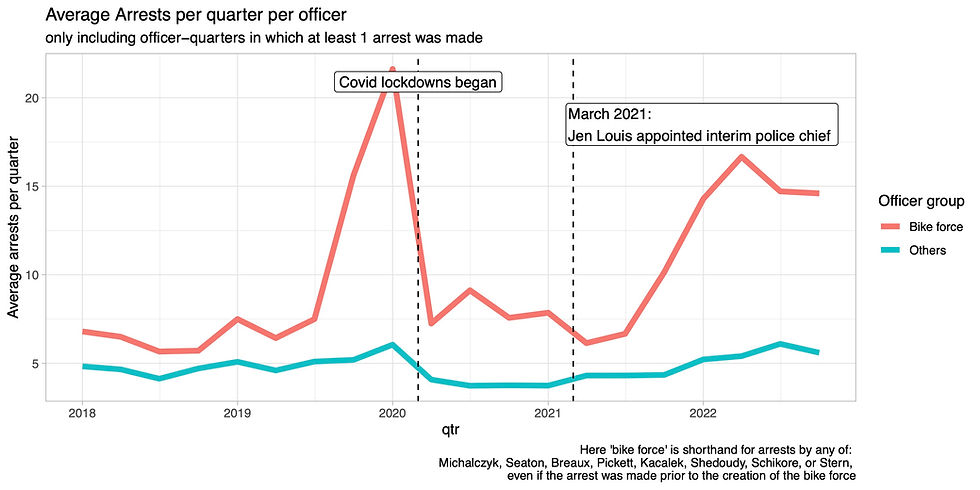Copwatch Response to City Manager’s Textgate Investigation
- berkeleycopwatch
- Jul 25, 2023
- 4 min read
The city manager’s “independent” investigation concluded and found no misconduct by the Berkeley Police Department. No racism. No arrest quotas. No violations of state or constitutional law. It’s not surprising that City Manager Dee Williams-Ridley, who presupposed that Jen Louis (the 20+ year veteran of the Berkeley Police Department who became interim police chief after former Chief Greenwood resigned in early 2021) had no knowledge of the offensive texts from the police bike force, would release a one-page summary of the limited investigation stating that there was no wrongdoing. This, even though all but one of the abhorrent texts were forensically legitimized.
The city manager’s investigation by San Francisco law firm Swanson and McNamara analyzed arrest data by the BPD bike force between October 1, 2019 through November 22, 2020. How can an analysis, let alone a conclusion, be drawn from such a small sample size of just over a year of data?
Berkeley Copwatch and the Human Rights Data Analysis Group analyzed five years of arrest data from January 2018 through December 2022. The chart below shows that the city manager’s investigation was only conducted during the time when arrests peaked, before the COVID lockdown. You can see in the chart that bike force officer arrests (the red line) far outnumber the arrests by officers in the rest of the police department (the blue line). The city manager’s investigation did not include an analysis of arrests before or after the spike.

Anomalies become apparent only when compared to arrest data before and after such a dramatic increase in arrests. How was the analysis made based on the limited data studied? This “investigation” is essentially a black box. We are given their conclusions without any mention of methodology and are expected to blindly believe their results.
Through Public Records Act requests, Berkeley Copwatch obtained arrest records from the BPD along with records from the Alameda County District Attorney’s office during Nancy O’Malley’s tenure as DA. Our analysis showed that in 2020 and in 2022, the number of arrests that the district attorney declined to prosecute reached as high as 35% of all bike force arrests, as compared to less than 20% of arrests in 2020 and less than 25% in 2022 for the rest of the department.
Data confirmed gross racial disparities department wide. In particular, according to the data, some individual officers have disproportionate rates of arresting people of color. For example, of all the arrests made by one veteran lieutenant over the five year period, 71% were African Americans. Data about other officers demonstrates similar bias.
After the summary report of the city manager’s investigation came out, we analyzed the same minimal data set as the investigators did and found that 44% of those arrested by the bike force were Black. In a city with less than 8% Black residents, this number demonstrates the striking racial disparities for which BPD has been criticized for years. It is blatantly untrue for the report to claim that there is no indication of racial bias.
To better understand how different officers use their discretion, we looked specifically at arrests that are coded as “on view by officer”, indicating the arrest was initiated not by a citizen complaint or court order but by the arresting officer. Compared to the rest of the BPD, on-view arrests made by bike force officers were much more likely to be dropped by District Attorney O’Malley – meaning the person arrested was not prosecuted or convicted of a crime. Officer Stern had 64% of his 61 arrests dropped. Officer Schikore had 51% of his 68 arrests dropped. Michalczyk had 49% of his 274 arrests dropped. Shedoudy had 44% dropped of his 34 arrests. And, Breaux had 41% dropped of his 49 arrests. Collectively, the non-bike force members of the BPD had 28% of their on-view arrests dropped.
Why did DA O’Malley drop so many more bike force officers’ arrests as compared with officers in other units? Were these arrests unnecessary? Did the investigation even assess this pattern? How did the investigators determine that there was no arrest quota? Unless the full report is released these crucial questions will remain unanswered.
Cheryl Owens, the former Police Accountability Board (PAB) member who led the investigation of the text allegations until she resigned the day after Jen Louis was promoted to permanent chief, was prescient when she said: “There is no collaboration on any front in this city, nor do I believe there’s a commitment to civilian oversight [of the BPD] by the city manager, the city attorney or the chief of police. When the PAB and the police chief disagree on a complaint finding, the city manager always sides with the chief. I don’t trust the city manager to give much weight to findings from the investigations into the text allegations if there are findings against the police department staff or the chief.”
If our city leaders had any interest in cultivating trust and building bridges with our most marginalized and most harassed residents of Berkeley, then they would make the entire report publicly available. Our city leaders have a choice. They can exonerate the BPD and endorse the flagrant racism in the department, or they can cooperate with a public investigation and ensure the PAB has full access to the documentation required to do their investigation of this matter, as 85% of Berkeley voters asked them to do.














Block Breaker is a well-known online game that blends focus, accuracy, and excitement into a straightforward but addictive experience. The player controls a paddle to keep a ball in play, aiming to destroy various formations of bricks and advance through levels in this game.